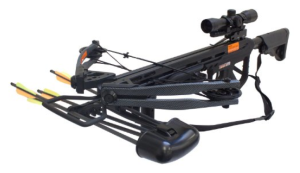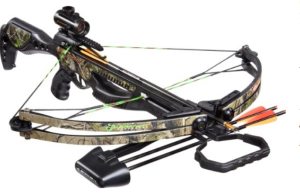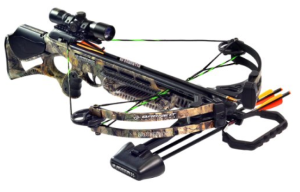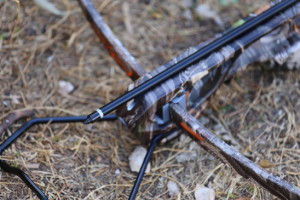The 185 Pound Tactical Compound Bow by Southland Archery Supply (SAS) is also known as the Torpedo model. This crossbow is reasonably priced between $399.00 and $449.00, so it is a good investment of the new archer as well as the skilled looking for a new bow to invest in or a new unit to add to one’s crossbow collection. The SAS 185 Pound Tactical Compound Crossbow’s design is sleek and clean. The exterior of the bow is jet black, and you get an ultra powerful bow for the price. The speed of this crossbow is 335 blistering feet per second, and the bow’s kinetic energy production is 102 ft-lbs. Great for target practice, competitions, or hunting, the Torpedo is a coveted crossbow among archers today.
An investment in the SAS 185 Pound Tactical Compound Bow means you get the crossbow, four aluminum bolts, a rope cocking device, protective glasses, rail lube, a 4×32 Scope, and a quiver. The draw weight of the bow is 185 pounds. The bow features a Picatinny rail that is positioned at the front of the bow for bipod or foregrip. An anti-dry-firing system protects you from firing the bow without a bolt in place and damaging your equipment or injuring yourself. The bow has a five position adjustable foregrip to ensure comfort and safe use. The stock is an AR-style Extensible Tactical Stock.
Design
 The SAS 185 lb Tactical Bow is one that features a light design. The bow weighs about 9.15 pounds, so it is heavier than some crossbows on the market, but not excessively so. The width of the bow is 24.25 inches and the length of the bow is 36.5 inches without the stirrup connected, and 40 inches with the stirrup attached. The power stroke of this crossbow is 14 inches. The bow is sold with an embroidered front sling quiver. Some archers may find the front sling quiver desirable while others may prefer a different style quiver to ensure ease of bolt access. The downside to the bow’s design is that it is only available in black and this may disappoint the hunter that prefers camouflage.
The SAS 185 lb Tactical Bow is one that features a light design. The bow weighs about 9.15 pounds, so it is heavier than some crossbows on the market, but not excessively so. The width of the bow is 24.25 inches and the length of the bow is 36.5 inches without the stirrup connected, and 40 inches with the stirrup attached. The power stroke of this crossbow is 14 inches. The bow is sold with an embroidered front sling quiver. Some archers may find the front sling quiver desirable while others may prefer a different style quiver to ensure ease of bolt access. The downside to the bow’s design is that it is only available in black and this may disappoint the hunter that prefers camouflage.
Accuracy
The SAS 185 lb Tactical Crossbow is impressive in terms of its speed and accuracy. The bow is sold with a 4×32 illuminated reticle scope to ensure the greatest visibility of the target. The illumination makes the bow perfect for hunts during pre-dawn and dusk hours. The scope features a red/green illumination feature, and it is fitted with flip covers to ensure clean lenses and the best visibility at all time from protected lenses.
Noise
As a crossbow, this model is somewhat noisy when you fire a shot off. Even in the face of the bow’s superior design, when the bolt releases from the rail on the bow, a sound occurs that could otherwise hinder your hunt. You will need to invest in silencers and dampeners to ensure the bow is as quiet as possible if you plan on using it to hunt live prey. Otherwise, the use of the bow may alert the target to your presence. It’s better to prepare in advance and get some accessories to quiet the bow’s action down. In lieu of silencers and dampeners, the bow is a better option for a shooter more accurate. When noise occurs, an accurate shooter has a greater chance of getting the prey down with one shot.
Safety
The fact that the manufacturer sells the SAS 185 Pound Tactical Compound Crossbow is a testament to their concern for the archer’s safety. The anti-dry-firing feature keeps you protected from potential injury. The foregrip with its adjustable positioning ensures maximum comfort and therefore safety due to a better grip of the device.
Warranty
The SAS 185 Pound Crossbow comes with a full three year warranty with purchase. The warranty will cover damaged products, replacement of parts, and repair of any defective parts. The warranty is hassle free.
Conclusion
The SAS 185 Pound Tactical Crossbow is a great buy in terms of price. You get enough power to hunt small game, and the bow is durable in terms of construction so you can count on the longevity of the model. With adequate care, the bow will last for years to come. If you are looking for a quiet bow, you’ll find that this bow has little vibration, but it will still need the help of a few accessories to make it as quiet as it can be so it is appropriate for the hunt. A unit great fort practice or hunting, The SAS 185 Pound Tactical Crossbow is a good choice for neophyte and skilled archers alike.



 Whether you refer to the shaft of your crossbow projectile as an arrow or a bolt, both references are correct. Remember, however, the word bolt applies to projectiles for use with a crossbow and the term cannot describe projectiles that work with a recurve bow. Before examining what features you should seek in the crossbow bolts you buy, it is necessary to examine the different parts of the bolt: Doing so will help you assess the features of existing bolts on the market with a clear understanding of arrow structure.
Whether you refer to the shaft of your crossbow projectile as an arrow or a bolt, both references are correct. Remember, however, the word bolt applies to projectiles for use with a crossbow and the term cannot describe projectiles that work with a recurve bow. Before examining what features you should seek in the crossbow bolts you buy, it is necessary to examine the different parts of the bolt: Doing so will help you assess the features of existing bolts on the market with a clear understanding of arrow structure.